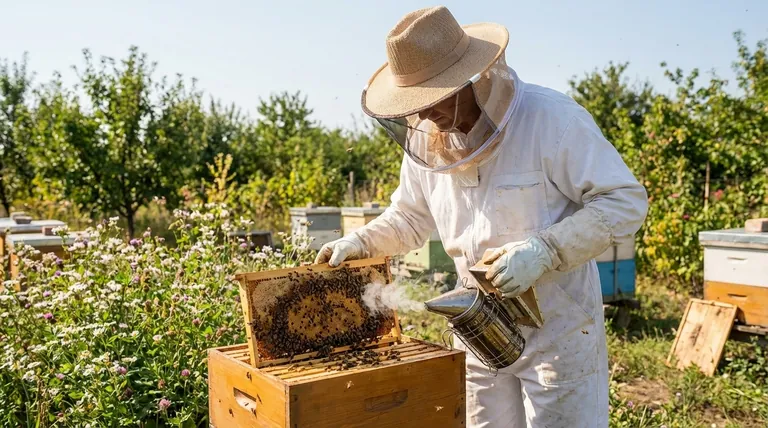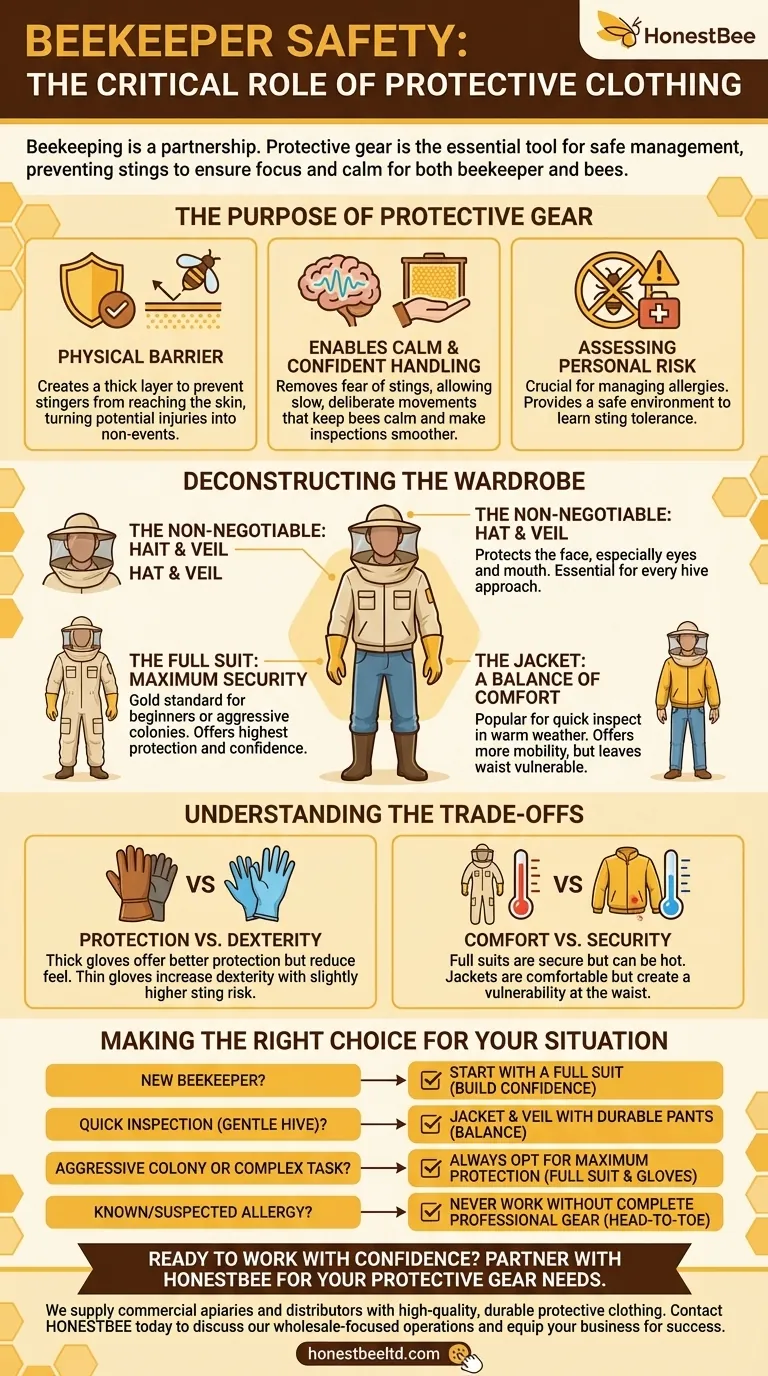At its core, beekeeping is a partnership with a wild insect. The most important tool for managing this partnership safely is protective clothing. Beekeepers wear this gear for the straightforward purpose of preventing stings, which are an inevitable risk when inspecting hives or harvesting honey. This protection allows a beekeeper to work with the necessary focus and calm, ensuring safety for both themselves and the bees.
Protective gear is not just about avoiding pain; it is a critical tool for managing risk and building competence. The right level of protection allows a beekeeper to remain calm and focused, which in turn leads to calmer bees and a safer experience.

The Purpose of Protective Gear
Creating a Physical Barrier
The primary function of beekeeping attire is to create a physical barrier between your skin and a bee's stinger. Even the most docile honey bee colony can become defensive when its home is opened for inspection.
Protective clothing is designed to be thick enough to prevent a stinger from reaching the skin, turning a potential injury into a non-event.
Enabling Calm and Confident Handling
Fear and anxiety cause jerky, rapid movements, which bees interpret as a threat. Wearing protective gear removes the fear of being stung, allowing you to move slowly and deliberately.
This confidence is key to effective beekeeping. A calm beekeeper fosters a calm hive, making inspections smoother and more productive. For beginners, this confidence is essential for learning without fear.
Assessing Your Personal Risk
For most people, a bee sting is a painful annoyance. For others, it can trigger a severe or even life-threatening allergic reaction.
Protective clothing is non-negotiable for anyone with a known allergy. For new beekeepers, it provides a safe way to work while learning how their own body tolerates the occasional sting that may find its way through a gap.
Deconstructing the Beekeeper's Wardrobe
The Non-Negotiable: A Hat and Veil
The single most critical piece of equipment is the hat and veil combination. Stings to the face, particularly around the eyes and mouth, are especially dangerous and painful.
Regardless of your comfort level or the gear you choose for the rest of your body, never approach a hive without a veil to protect your head and face.
The Full Suit: Maximum Security
A full bee suit offers head-to-toe coverage, typically integrating the suit, veil, and leg coverings into a single garment.
This is the gold standard for beginners, as it provides the highest level of protection and builds confidence. It is also the necessary choice when dealing with an aggressive colony or performing a complex hive manipulation.
The Jacket: A Balance of Comfort and Protection
A beekeeping jacket is a popular option that provides protection for the entire upper body and includes an attached veil. Beekeepers typically wear it with a durable pair of jeans or heavy cotton pants.
This setup offers more comfort and mobility than a full suit, making it a common choice for quick inspections in warm weather, especially with known, gentle hives.
Understanding the Trade-offs
Protection vs. Dexterity
The more protected you are, the less you can sometimes feel. Thick leather gloves, for example, offer excellent sting protection but can make it difficult to handle frames or a queen bee gently.
Many experienced beekeepers opt for thinner nitrile or goatskin gloves to maintain dexterity, accepting a slightly higher risk of stings to the hands.
Comfort vs. Security
The primary decision for many beekeepers is between a full suit and a jacket. A full suit can be hot and cumbersome, but it offers near-total peace of mind.
A jacket is far more comfortable and quicker to put on, but it creates a potential vulnerability at the waist where the jacket and pants meet. The choice often depends on the climate, the task at hand, and personal risk tolerance.
Making the Right Choice for Your Situation
Your protective gear is a tool, and you should select the right level of protection for the job. Your choice will depend on your experience, the temperament of your bees, and the task you are performing.
- If you are a new beekeeper: Start with a full bee suit to build confidence and safely learn bee behavior without the distraction of fear.
- If your primary focus is a quick inspection of a known, gentle hive: A jacket and veil paired with durable pants may provide a sufficient balance of protection and comfort.
- If you are working with an aggressive colony or performing a complex task: Always opt for maximum protection with a full suit, gloves, and closed-toe footwear.
- If you have a known or suspected bee venom allergy: Never work with bees without complete, professional-grade protective gear from head to toe.
Ultimately, proper protective gear empowers you to be a more effective, confident, and responsible steward of your hives.
Summary Table:
| Key Aspect | Purpose & Benefit |
|---|---|
| Physical Barrier | Prevents bee stingers from reaching the skin, turning potential injuries into non-events. |
| Confident Handling | Reduces fear and anxiety, allowing for slow, deliberate movements that keep bees calm. |
| Risk Management | Essential for beekeepers with allergies and for beginners to learn safely. |
| Gear Options | Full suit (maximum security), Jacket (balance of comfort/protection), Hat & Veil (non-negotiable). |
Ready to Work with Confidence? Partner with HONESTBEE for Your Protective Gear Needs.
Your safety and the well-being of your bees are paramount. At HONESTBEE, we supply commercial apiaries and beekeeping equipment distributors with high-quality, durable protective clothing designed for the demands of professional beekeeping. From full suits for maximum security to comfortable jackets for quick inspections, our gear empowers you to work effectively and responsibly.
Let's discuss how our wholesale-focused operations can equip your business for success. Contact HONESTBEE today to learn more about our products and pricing.
Visual Guide

Related Products
- Beekeeper Cowboy Hat and Veil for Beekeeping
- Yellow Plastic Bucket Pail Perch for Beekeeping
- High Security Emlock Strap System
- Long Langstroth Style Horizontal Top Bar Hive for Wholesale
- Wooden Bee Brush with Triple Row Artificial Fiber for Beekeeping
People Also Ask
- How should the beekeeping hat veil be cleaned? The Only Safe Method to Preserve Protection
- Why is head protection important for beekeepers? Essential Safety for Confident Hive Management
- Why is protecting the head important in beekeeping? Essential Safety for Every Beekeeper
- How does the design of the beekeeping hat ensure comfort during extended use? Maximize Comfort for Long Apiary Hours
- What activities is the beekeeping hat suitable for? Beyond the Hive for Ultimate Outdoor Protection



















